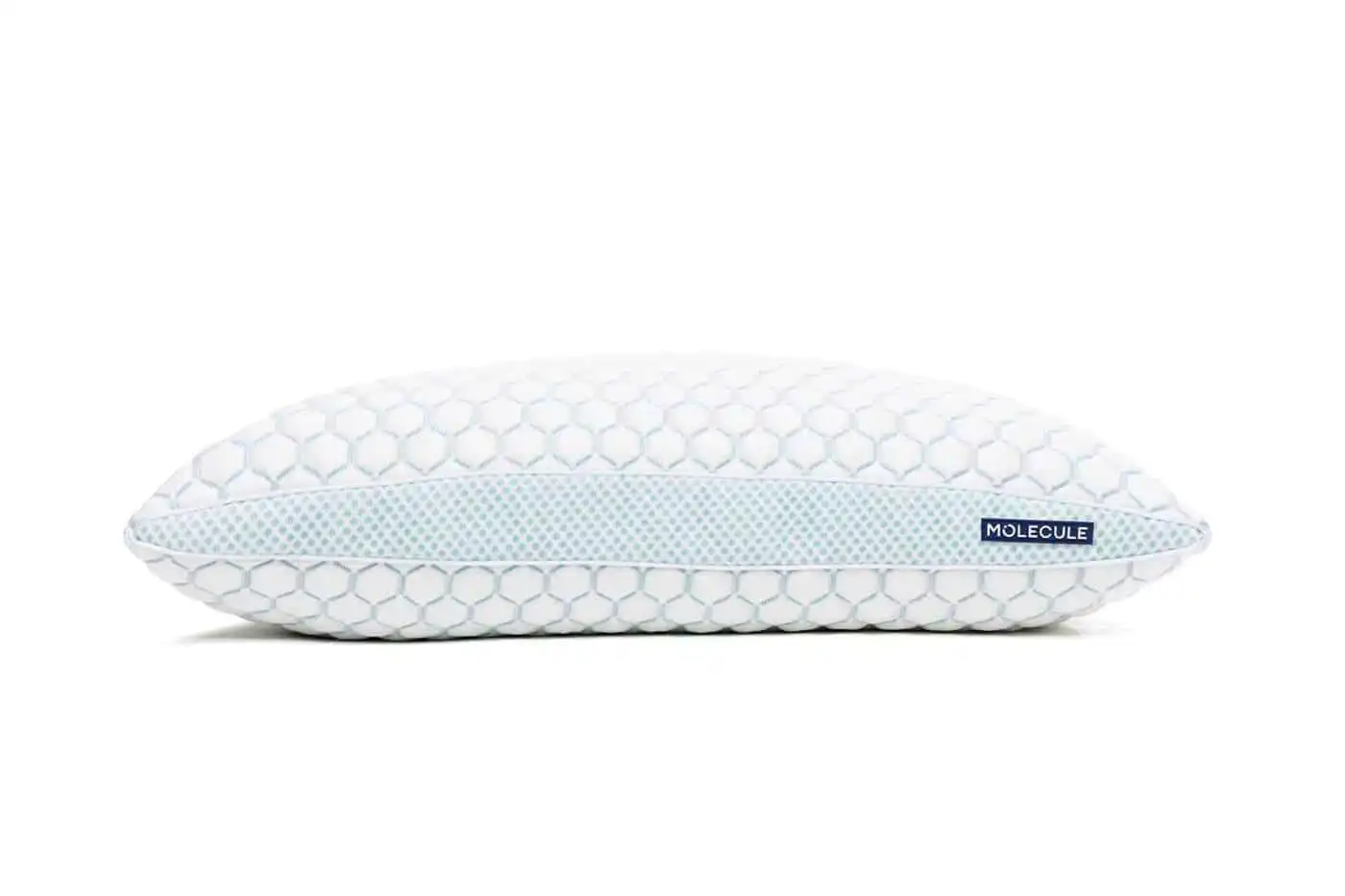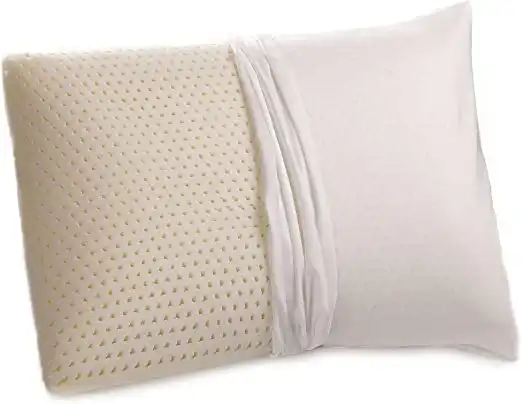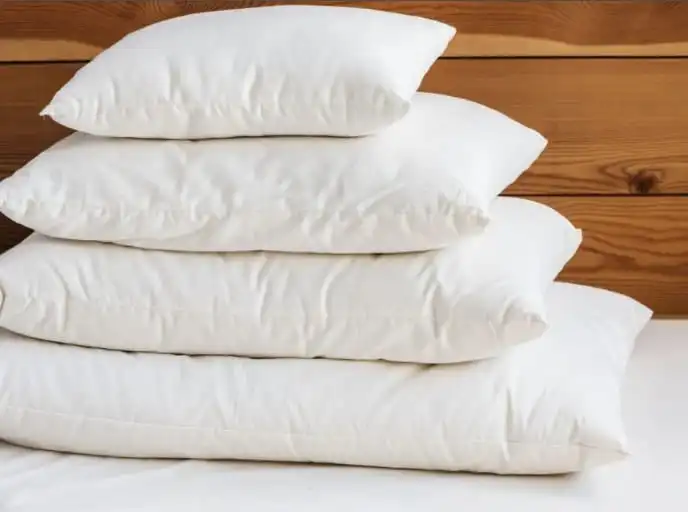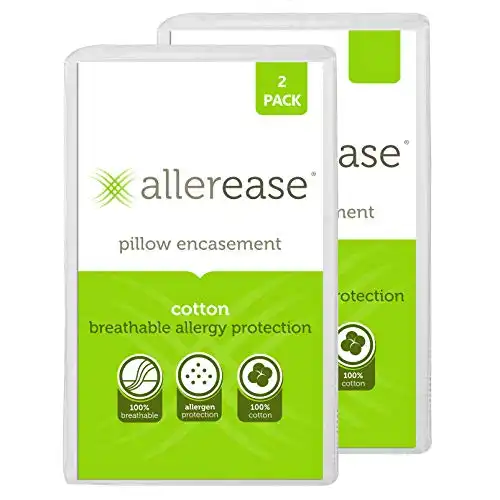- You are here:
- Home »
- Organic Bedding »
- Is My Pillow Toxic?
Is My Pillow Toxic?
Disclaimer: As an Amazon Associate I earn from qualifying purchases.
Pillows are an integral part of our sleep. They provide comfort, support the neck and head, and help us fall asleep. But what if your pillow is actually toxic? What’s in your pillow that could be making you sick? The answer might surprise you.
In this article, we’ll look at what’s inside your pillow, and some simple ways you can adjust your sleep environment to minimize the toxins in your bed.
Toxic Chemicals Used In Pillows
In this section, we’ll look at the various chemicals that can make your pillow toxic. If any of these chemical groups are listed on the pillow label, you should try and find a safer alternative.
Flame retardants
Some pillows use flame-retardant chemicals such as PBDEs (polybrominated diphenyl ethers) and TCDFs (tetrachlorinated-dibenzo-p-dioxins). Research has shown that some of these chemicals can cause allergies, neurotoxicity, hormone disruption and cancer.
Such pillows are usually made of polyurethane foam filled with a combination of materials, including chemical flame retardants that meet flammability standards set by the U.S. Consumer Product Safety Commission. Fortunately, nowadays many pillows use natural flame retardants such as wool, which work just as well.
Make sure to check the label on your pillow for chemical flame retardants and always choose products without them when possible.

Formaldehyde and Other Protective Finishes
Some pillowcases are made with a protective finish. These finishes not only make the pillow look cleaner longer, but also help to prevent dust mites and other allergens from breeding in your pillows. Unfortunately, some of these finishes can contain formaldehyde or other chemicals that may cause health problems.
For instance, formaldehyde is used for wrinkle resistance and improves the penetration of dyes and inks on textiles. However, this chemical can cause cancer and allergic reactions.
Polyester
Many pillows are filled with polyester or they use polyester covers. This synthetic material can cause a lot of health issues, such as allergies, rashes, and breathing difficulties. These issues are usually triggered by tiny particles that can get attached to your skin or fly into your nose.
Many of these polyester pillows are treated with chemicals that can irritate your skin even more. Some cotton and polyester blends are treated with formaldehyde, which can make your pillow toxic. There is evidence that formaldehyde, apart from being a known carcinogen, may cause respiratory problems and dermatitis.
Perfumes and Deodorizers
These substances may be used in pillows to mask any chemical smells. In some cases, fragrances that have been tested on animals have been used in pillows for this very purpose.
These perfumes and deodorizers can also irritate your skin and cause breathing difficulties and coughing, so it’s best to stay away from any kind of pillow that uses them.
VOCs (Volatile Organic Compounds)
Some pillows release harmful chemicals called volatile organic compounds (VOCs). These chemicals can be released after new pillows have been made and/or set out to “air.” This is called off-gassing. VOCs are linked to cancer, reproductive harm, and lung damage.
Read More: Are Memory Foam Pillows Toxic?
What Kinds of Pillows Are Most Toxic?
The most toxic pillows are memory foam pillows. Memory foam is made from petroleum or polyurethane and other chemicals. Some of them are known carcinogens, and others can cause allergic reactions, especially in people with chemical sensitivities.
If you really need a memory foam pillow, consider buying a CertiPUR-certified pillow. This certificate means that the foam has been tested and proven to be safe.
Although feather and down pillows contain fewer chemicals, they are typically washed in bleach and treated with other chemicals, such as deodorizers. If you think your down pillow might be a health concern, consider choosing Greenguard GOLD-certified pillows guaranteed to have very low VOC emissions.
Why Choose Organic Pillows?
Organic pillows are made of organic cotton, wool, and latex. These materials are GOTS or GOLS certified, which guarantees pesticide-free farming and production processes that adhere to strict rules concerning the use of chemicals. The benefits of using all-natural pillows include:
Improved sleep
Organic pillows are made of soft, natural materials that feel good against your skin. Because these materials don’t have the chemicals found in other pillows, they won’t irritate your skin or release fumes while you sleep.
Fewer allergens
Organic pillows are less likely to trigger allergies. Unlike synthetic pillows, they don’t off gas any toxic chemicals. If you have allergies, an organic pillow will help you breathe easier at night.
Natural materials
Organic pillows use certified natural cotton and wool, so they won’t cause irritation or contain harmful substances. These materials provide a healthier sleeping environment and can reduce issues associated with conventional synthetic materials.
Eco-friendly
Since organic pillows are made from natural materials, they will break down naturally in the landfill or can be easily recycled. As fewer harmful substances are used during the production process, organic pillows are friendlier to the environment.
More Durable
An organic pillow can last longer than conventional pillows. It’s because the organic fibers have not been bleached, or chemically processed so they are stronger and more durable than other pillows.

Best Natural Pillow Materials
In this section, you will learn about the various natural materials that are best used to make pillows. These organic pillows are available with GOTS and GOLS certificates, meaning they have been produced by sustainable methods and are free from harmful chemicals. Take a look:
Natural Latex Pillows
Pillows made of GOLS-certified natural latex are soft, hypoallergenic, and breathable. Latex itself is naturally resistant to mold, mildew and dust mites. Also, latex has anti-bacterial and anti-fungal properties.
You can find organic pillows filled with shredded latex or solid latex foam depending on your preferences. They offer good support and they never go flat. Shredded latex pillows may be more comfortable for those who like pillows with a little more give and they are more malleable. Solid latex pillows offer better support and they do not change shape at all.
Material: Oeko-Tex certified natural latex and cotton cover
Read More: Latex Pillows Pros and Cons
Wool Pillows
Wool pillows can be expensive, but they’re worth the investment if you suffer from allergies and/or sleep hot. Organic wool pillows help to regulate temperature, wick away moisture and are naturally hypoallergenic.
However, natural wool pillows tend to flatten over time so you should re-fluff them every day to keep them in shape.
Materials: GOTS-Certified Wool and Organic Cotton Sateen Case
Sizes: Travel, Standard, King, Queen, Euro
Kapok Pillows
If you’re looking for a softer alternative to down, kapok pillows are about as close as you can get. Kapok comes from the seed pods of the Kapok tree and is a very soft, silky fiber filled with air.
Kapok pillows are a good option for people with allergies to wool or down. Although this organic pillow fill is resilient, it does require fluffing to retain your pillow’s original shape.
Materials: GOTS Certified Kapok and GOTS Certified Cotton Cover
Buckwheat Pillows
Buckwheat is a naturally gluten-free grain that can be grown in a wide range of soils and climates. The hulls are tough yet light, and buckwheat pillows fill a room with comforting rustling sounds when you move around.
These eco-friendly, biodegradable pillows will contour your head and neck, providing fantastic support, and at the same time, they won’t make you sweat thanks to the excellent airflow they provide. To make the most of your buckwheat pillows, you’ll need to fluff them every night before going to bed.
Are Memory Foam Pillows Toxic?
If your memory foam pillows are made of man-made materials, such as gel and memory foam, then chances are they are toxic. These pillows may off gas toxic chemicals that are dangerous to your health.
The off-gassing process produces a chemical smell that is usually released by a new pillow made of synthetic materials. There have been possible links of cancer, infertility and birth defects due to these potentially toxic chemicals being off-gassed from cooling pillows and other foam sleeping products.
If you want to buy a synthetic cooling pillow, look for those with a CertiPUR-US certificate. This certificate ensures the pillow uses foam that has been tested for harmful chemicals.
Allergens in Pillows
There are some allergens that could make your pillows toxic and cause unpleasant symptoms such as sneezing, headache, or runny nose. Take a look at some common allergens in pillows.
Dust Mites
Dust mites are a natural part of indoor environments. They feed on dead skin cells that we constantly shed, particularly while we sleep at night.
When dust mite droppings accumulate in a pillow, they can make it heavier over time and cause health problems for people with allergies or asthma. If you want to prevent this problem, be sure to vacuum your pillows regularly and wash them according to the manufacturer’s instructions.
Fungus
According to research, the most common fungi species in our households is Aspergillus. This fungus can exacerbate asthma symptoms.
It’s especially dangerous to immuno-compromised people who suffer from leukemia, AIDS or underwent organ transplants, as it can cause life-threatening pneumonia or sinusitis. Synthetic and down pillows have been found to harbor more fungi than other types of pillows.
Molds
If your pillow gets wet from accidental spills, drooling, or sweat, it can become a breeding ground for molds. Moving the pillow from one location to another is a quick and easy method to spread mold around your house.
If you breathe or touch mold, you might get sick, so keeping your pillow dry is the key to preventing mold growth. Your best bet is to use waterproof pillow protectors.
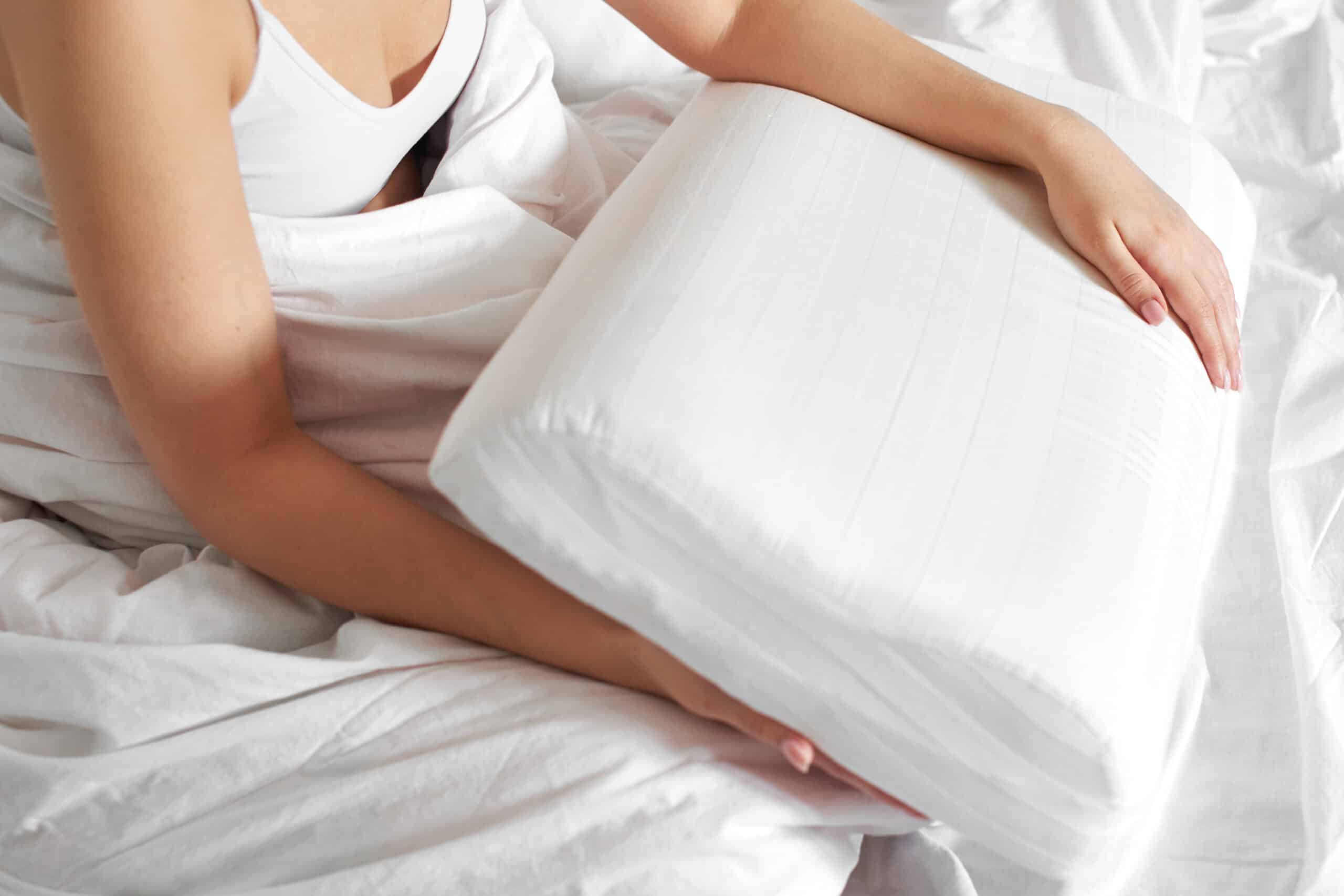
Using Allergy Pillow Covers
Allergy pillow covers will protect you from harmful chemicals and allergens. Some covers will even protect your pillows from dander, mold, and bacteria that may cause an increase in allergies or asthma symptoms.
It’s best to buy GOTS-certified organic cotton pillow protectors as they are free from harmful substances like pesticides, formaldehyde or bleach. Pillow covers help to keep your pillows fresher for a longer time by keeping them dust-free and reducing allergens.
Materials: 100% Cotton
Sizes: Standard, Queen, King
Read More: Why use a pillow protector?
What to Consider When Shopping for a Non-Toxic Pillow?
- The Material: The vast majority of pillows are made from synthetic materials, the most common being polyester or memory foam. If you’re looking for something more natural, check out natural latex, kapok and buckwheat pillows.
- The Covers: A good number of pillows have fabric covers that are made of polyester, which can be toxic. Make sure you pick pillows with GOTS-certified organic cotton covers. It’s also helpful if they’re removable for easy washing.
- Certificates: A good manufacturer will list the contents of their pillows on their website. Look for pillows that contain at least 95% natural ingredients, and are GOTS-certified organic or OEKO-TEX certified to be free of toxins. If you want to buy memory foam pillows, be sure they’re CertiPUR certified, which means that it’s made of low-emission materials.
Keeping Your Pillow Clean
If you don’t take care of an all-natural or synthetic pillow properly, it might become poisonous, no matter what sort of pillow you pick. It is important to keep your pillows clean in order to avoid any potential allergens and contaminants. Here’s a list of things to do to keep your pillows allergen-free:
- Be sure to wash your pillowcases about once per week. Washing them in hot water will kill dust mites, allergens, and bacteria. If your pillows have removable shells, you can wash these too.
- Wash your pillows at least once or twice a year whenever possible. Check the label for washing instructions before you toss them in the washing machine.
- Use a bed bug and dust-mite-proof pillow cover. Make sure it’s made from natural, breathable materials, such as organic cotton, that will prevent you from sweating while you sleep.
- Make sure to use only mild cleaners on your pillows so that they do not become damaged by harsh chemicals. It is also better for sensitive skin.
- Frequently vacuum your pillows so you can remove dust mites and dead skin cells. Your pillows will also benefit from the clean air circulating around them if they are regularly vacuumed so that they last longer.
- If you suffer from allergies or asthma, keeping your pillow free of dust mites that cause respiratory problems is important. It is also important to note that latex and rubber pillows are some of the best for people with allergies since they don’t trap dust mites like other pillows do.
- Always keep your pillows dry. Don’t go to bed with wet hair and dry your pillows immediately if they get wet. Also, protect them from getting soaked with makeup or lotions if you use these products. A waterproof pillow protector will help you keep your pillows safe.
- You can place your pillows outside in hot weather or freezing cold for 24 hours to kill dust mites and keep them fresh.
- Consider replacing your pillows after 1 to 2 years. It’s hard to say how long pillows last since they are all made differently, but if yours become lumpy or no longer provide the support you need, then replace them with new ones.
Conclusion
We hope this article helped you find out if your pillow is toxic, what to look for in the labels, and what you can do to keep your pillows clean. Keep in mind that there are many types of pillows and it can be hard to decide which ones are the right fit for you.
If you’re looking for a non-toxic pillow, we strongly recommend natural latex, kapok and buckwheat pillows if you want something natural. If you prefer memory foam or polyester, look for CertiPUR-certified pillows; if you want to be completely safe, stick with organic cotton covers.
Most importantly, make sure to take good care of your pillow so that it stays healthy and free of contaminants for as long as possible. You can do a lot to extend the life of a pillow, including washing it on a regular basis, keeping it dry, and avoiding harsh detergents.
As always, the best thing you can do is to stay informed about what products are good for your health. If you’re uncertain about the safety of your pillows, please feel free to leave us a comment below. We will try our best to answer all questions as soon as possible.

About the Author Kamila Flieger
My name is Kamila, and I'm passionate about researching non-toxic, organic products for the home. I believe it's so important to create a safe and healthy environment for our families, and I enjoy helping others do the same.

